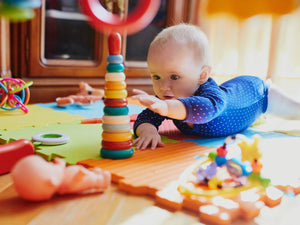Toilet training is an important stage of childhood development. Most children are ready to start toilet training from around the age of 2 years onwards. However, some aren’t ready for another 6-12 months.
It’s important to remember that every child is a unique little individual. The combination of genetics, environment and their own personality and temperament will all play a role in how they learn to become toilet trained.
Aren’t you Clever?
The age at which children are toilet trained is not an indication of their intelligence. Toilet training requires a complex series of signals between the bladder/bowel and brain, which alert the child to needing to use the toilet.
Busy toddlers are fully focused on what’s in front of them. In the early phases of toilet training, it’s normal for young children not to recognize they need to wee or poo until it’s too late.
Avoid punishing your toddler for accidents. There is no room for great praise or punishment, in toilet training.
Be positive and stay calm over the weeks or months it takes your child to get there.
Signs That Your Toddler is Ready to Toilet Train
If they -
- Recognize when they are wet or dirty or, are about to be.
- Are waking up dry from their daytime sleeps.
- Are waking up in the morning still dry, or, the wee in their nappy is warm. This is a sign they may have just weed, and are ready to go without a night nappy.
- Call out to you in the night that they want to go to the toilet. This may be a sign that they’re ready for night time toilet training.
- Can “hold on” to their wee or poo until they get to the toilet.
- Begin to show some interest in using the toilet.
- Try to remove their nappy after they’ve weed or pooed.
- Seem to be irritated by wearing a nappy.
- Are having a regular pooing routine, and you can pretty well predict when they’re likely to poo.
How to Begin Toilet Training
- Make sure your toddler is dressed in clothing which is easily removed. Summer and the warmer months are an easier time to start toilet training.
- Consider if you’d prefer your toddler use a potty first and then transition to using a toilet or, use a toilet from the start. There are pros and cons either way.
- Take your toddler to the toilet when they first wake in the morning or from their day naps. And take them to the toilet again last thing at night before they go to bed.
- Pick up on your child’s cues that they need to go. Stepping from one foot to the other, holding themselves, looking distracted are all signals that it’s time to get to the toilet.
- Take your toddler to the toilet every couple of hours. Help them and don’t be in a rush to get them to finish.
- Praise attempts, even if they don’t wee or poo.
- Ask your toddler if they want to do a wee or poo. Sometimes, toddlers start in their nappy and then finish when they’re sitting on the toilet.
- Make sure your toddler feels comfortable sitting on the toilet seat. Steps and a toilet seat insert can help with this.
- Avoid toilet training when there are lots of other things going on in the house. A new baby, house move, starting childcare, are all potentially stressful. Pick your time.
- Aim for a quiet few days at home when you’re first introducing the concept of toilet training. If it all gets too hard and you feel your toddler isn’t ready, stop for a while, go back to nappies and try again in a few weeks’ time. There’s no rush.
Top tips for Toilet Training
- Start the process when your toddler is showing you they’re ready. Save yourself lots of energy by following their lead.
- Give praise, but not too much of it – your toddler shouldn’t feel pressured to perform. The best approach from parents is to be matter of fact.
- Start small and build on skills. Help them to recognize that they’re wet or about to be. Show them where the toilet or potty is, make sure they can sit on it comfortably and praise their attempts.
- Role model what’s involved by sending your child to the toilet with the same gender parent. Don’t be shy. Your child can’t learn what they don’t see or hear.
- Don’t expect toilet training to be a smooth, one directional process. Children often regress as they learn all the skills involved.
- If your child has an accident, involve them in the clean up and changing. Ask for their help in taking wet/soiled clothing to the laundry, cleaning themselves and assisting with dressing.
- Don’t get too hung up on your child getting to the stage of no longer using nappies. Boys especially, can take longer than girls to get the hang of using the toilet.
- Decide what works for you and your male toddler. Boys can learn to either stand up to wee or, sit down. You may want to get a toilet seat insert with a guard to avoid splashes.
- Remember, small children only have a small bladder. They need to go to the toilet more frequently than adults.
- The bladder and bowel have separate nervous pathways. Just because your child may be toilet trained for wees, is not a guarantee that they are at the same level with their bowels.
- Night time bed wetting can continue well into the early years of primary school. Again, boys are more prone to night time wetting (enuresis), than girls.
- Avoid your toddler becoming constipated. If they associate pooing with pain, they’re likely to hold on. Make sure they’re having enough water to drink and fibre in their diet.
- Ask your toddler to flush when they’re finished. Some toddlers believe that they’ll disappear into the toilet and become very frightened. In this case, a potty may be a less scary alternative.
- Teach your toddler to wash and dry their hands when they’re finished. Make sure they know this is a routine part of toileting.
Check with your Child Health Nurse if you’re concerned about your child’s toilet training. Sometimes there are reasons why toddlers are delayed with toilet training. It can help to have the support of a healthcare professional.
Written for Nourish by Jane Barry, Midwife and Child Health Nurse.
Our Products
-

01. Guide to a Healthy Pregnancy
$55 -

02. Positive Birthing Course
$55 -

03. Infant Feeding Guide
$55 -

04. Baby Sleep Guide - First 12 Months
$55 -

05. Toddler Parenting Course 1 - 3 Years
$55
-
 When to Start Antenatal Classes?
When to Start Antenatal Classes?
Becoming a parent is an incredible milestone, but it comes with a host of changes that can be daunting, especially for first time parents. Antenatal classes are all about offering expectant parents the education they need to make informed decisions, look after their bodies and care for their newborn babies. While you probably already have a long list of things you need to accomplish during your pregnancy, it’s a good idea to make time to attend antenatal classes.
-
 Development Milestones 4-8 Months
Development Milestones 4-8 Months
As they reach the middle of their first year, you'll start to see bigger leaps in their growth and ability!
In this article, we’re going to discuss your baby’s developmental milestones between 4-8 months, and what you can expect along the way.





 When to Start Antenatal Classes?
When to Start Antenatal Classes?
 Development Milestones 4-8 Months
Development Milestones 4-8 Months








